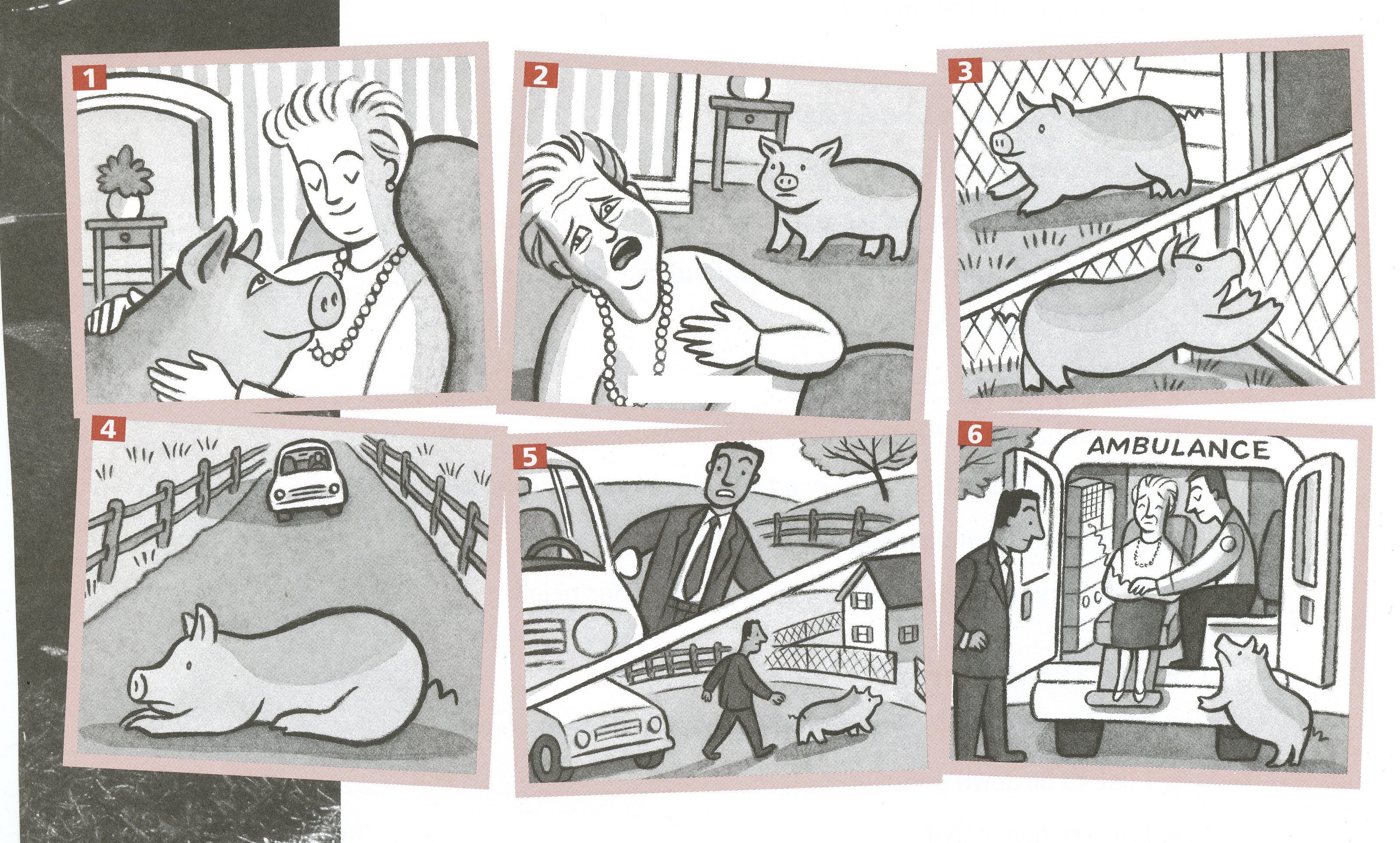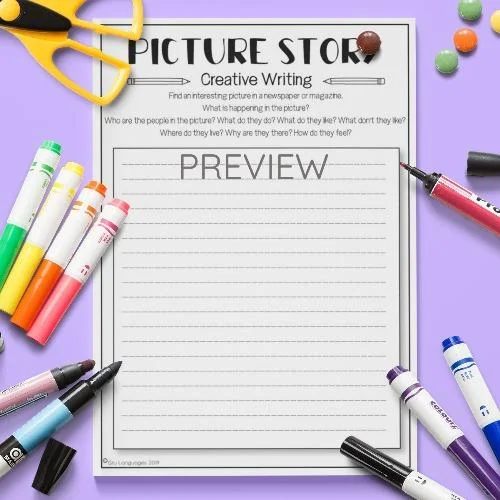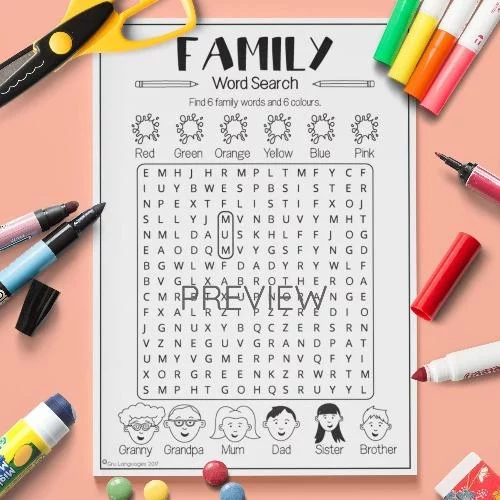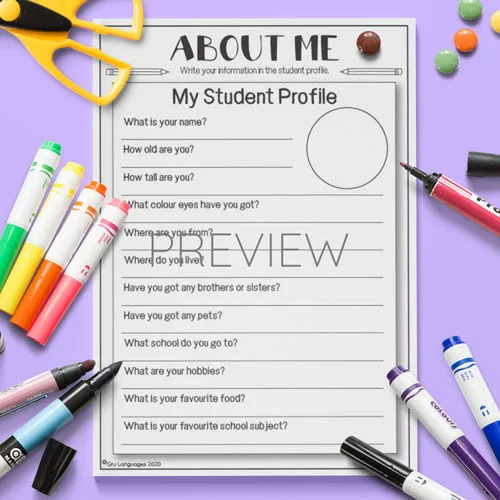Explorations


An ESL Lesson: Writing a Story Using Picture Prompts and Correction Marks
To the teacher: I took the idea for this lesson from an ESL workbook that I used many years ago. Nothing remains of the book, but for this picture, which I now use as a prompt to get students to write a story together. My lesson is very different from the lesson that was in the workbook originally so there is no plagiarism here—all I can do is thank those forgotten authors from long ago. All good lessons get borrowed and become the lessons of others.
… Objective:
By working together students will write a story after making a list of words that they will need to write it.
Teacher talk and discussion Groups of three, individuals
Bilingual dictionaries Newsprint and markers Blue painter’s tape
High beginner to low intermediate but a good teacher can make a lesson accommodate any student level
PDF File: Picture Prompts and Correction Marks:
Pig Story, Picture Prompts and Correction Marks
… Progression: …

Looking and discussing. Place students in groups of three and hand out the pictures. Tell them that they are going to make a list of all the words they see when they look at the six pictures. They may use bi-lingual dictionaries to find the words they know in their own languages, but not in English. Tell them they are going to make a list of all the nouns, adjectives, adverbs, and verbs that they see, especially the verbs. What’s happening? …

Making a list and discussing the words listed. Students may write their lists on newsprint or on the board. When the lists are finished, hang them up on the wall in different parts of the classroom. Now, the students in their groups should get up and go from newsprint to newsprint examining the words. Some students like to stay seated, but get them up and interacting. Everybody looks at all the words generated. Most words, of course, will be similar, but some will not. Focus on the differences, the spelling, and what part of speech each word is.
Note: for hanging up newsprint, by the way, I like to use blue painter’s tape because it doesn’t leave marks on the wall when the lesson is over and the newsprint is taken down. …

Writing a story. Using their new vocabulary, each group will write a story creating it together. Tell them to choose one tense to write in, either the simple past or the simple present. There can be one designated writer, or students can take turns writing, but all the students in the group must add words and ideas to the story. The teacher circulates to make sure that this is happening. All hands on deck! …

Reading and correcting the story. As each group finishes, the teacher can take the newsprint and hang it up. But before the groups get up to read the stories, the teacher should familiarize them with correction marks first because the students are going to need to know how to use them so that they can edit and rewrite later. I have provided a list of correction marks below that my students have used successfully.
Once the students have reviewed the correction marks, let them get up in their groups and look over every story. Give each group a marker to make their own corrections. When finished, every story should have correction marks from every group. The teacher, after the students have corrected, goes over every story one more time to point out any correction errors and make any final corrections.
… Correction Marks

To the teacher : I did the corrections in the story above. It was the first time the class worked together, so I modeled the correcting. Honestly, any correction mark, even a simple check, will do as long as it designates the spot where an error has occurred: knowing where the mistake is is what is important.
Using more specific correction marks allows teachers to indicate mistakes without correcting the work themselves. Letting students know what kind of correction is needed, alerts them to the kind of mistake they have made so they can more easily narrow in on what they need to do to correct it.
There can be several drafts where teacher and student work together toward a perfect paper, but on each draft the teacher indicates where the correction is needed and the student makes the correct correction. The teacher should never rewrite the student’s paper. The student must do that. …
When students work in groups, they get to know each other better and that is dynamic for a class. And, after working together students are much more able to work alone. The skills students observe in others become their own. …
Share this:
11 comments.
Hi Don. I love this lesson! Do you have the picture prompts available?
I have added a downloadable PDF file.
Thank you, Don. I’m going to download the pictures when I get to school!
Please let me know if it works.
Wow, that’s absolutely amazing, I’ll do it when i start teaching
Quite sure it’s an effective method. Please, where can I get more
Thanks for sharing this amazing post. It will be helpful to my daughter to read your article
Genuine advice. Really helpful.
Thanks for sharing that Don. Do you happen to know the name of that old book which you took the set of illustrations from? Many thanks for any help you can give. Eamonn
I think it might come from a series, Very True Stories, but I only have the picture, not the book.
Creative and helpful guide for storytelling with picture prompts!
Leave a Reply Cancel reply
Thank you, Donna
brilliance abounds!!! shared at word pond
Oh bless you for the T S Elliot. It sent shivers down my back to hear him read. I fell…
Dear Alicia, ever as sharp as more than many knives and yet allowing we her readers/hearers to laugh at her…
[…] Source: Basil King’s Illuminations – Don YortyDon Yorty […]
- Professional development
- Managing resources
Picture stories in the communicative classroom
Pictures are all around us everyday, in the street, at work, at home and even in our leisure time, so why not in the classroom as well?

They are enjoyable, they set the scene or context, they inform us, they interest us, they are a key resource. To be even more specific, picture stories are also common in everyday life. Look at the cartoon strips in newspapers or comic books and the enjoyment which we derive from them.
Picture stories are often neglected or used in a very predictable way in the classroom, usually as a starting point for a narrative speaking and ultimately writing activity, but they can also be of key importance in the communicative and interactive classroom.
- Why I use pictures
- Finding picture stories
- What I do with a picture story
Why I use pictures As well as enjoying pictures they also form a key resource for accessing the different learning styles that each student has. Using pictures really appeals to visual learners who may suffer in a speaking and listening based classroom. They also offer an opportunity for movement and a multi-dimensional perspective which will reach our kinaesthetic learners.
- Pictures aren't based on level. Of course we can choose certain pictures to access a certain area of vocabulary if we wish but any picture can be the base of any kind of activity at any level. Reading stories can restrict our students but an elementary learner can access the most complex story through pictures so lower levels don't 'miss out' on the 'exciting' stories that the higher levels are looking at.
- Of course, as we take our enjoyment from pictures in everyday life so our students take enjoyment from the pictures in the story. They will add a touch of intrigue to the class and make the lesson much more dynamic as imaginations are aroused. This is especially useful with those students who find it difficult to use their imaginations. The picture story provides a support and ideas which the students can then build on more easily than inventing their own story all together.
- I find that picture stories also add pace to my classes. The students' reaction to a picture is almost immediate whereas the same reaction from a written story would take much, much longer. The students are interested and enthusiastic right from the beginning of the class.
Finding picture stories Digital photos Now that digital technology has become widespread and accessible to all, digital photos taken by either the students or the teacher are particularly useful for picture stories. Not only can the students then be involved in making their story but they could also use technology to manipulate them, changing colours, styles or sequences and deleting what they don't want or need. Internet The internet is a fantastic source of pictures and can be found related to any topic through major search engines. This adds the bonus of being right up to date, perhaps the latest film or cartoon characters or the students' favourite football players. Magazines and newspapers These provide a constant supply of topical pictures in a wide range of styles, colour, black and white, photographs and stylised images to name but a few. There are also ready-made picture stories in the form of cartoon strips and comics which could be used, perhaps after deleting any text which appears. Drawing For those more artistic teachers and students among us there remains the option of drawing our own picture stories. If you feel you need more support however, there are pictures and picture stories in the English language course books that we are currently using which we can adapt. Pocket pictures Last but not least, let's not underestimate the power of sketches or stick men on little pieces of paper or sticky-backed notelets! They are accessible, fun and add another dimension to the usual class.
What I do with a picture story As well as the well-known and loved written narrative based on a picture story, which enables students to practise their past tenses and linking words, there are many ways we can use picture stories to encourage our students to develop their spoken communication skills.
- Rather than writing a narrative, I find that students respond well to telling their stories out loud to others in the class. It is a challenging activity which can be done in pairs or as a group, depending on the size of the group and the personalities of the learners.
- To make the story-telling activity more interactive, those students who are listening make notes and react to the story with appropriate interest, asking questions if and when necessary.
- Instead of just responding to a picture story, students can be fully involved in making it, collecting their own pictures and perhaps then giving them to another group to develop the story. Students can rearrange the pictures to change the sequence of events and make quite a different story. A competition for the best story adds an extra incentive for being creative.
- While one student tells a story orally based on his/her set of pictures, the student or students listening do line-drawings to recreate the pictures their partner has. These can then be compared after the activity and students can check whether they explained and understood correctly.
- What happens next…? This kind of activity can be used as the basis of a class discussion. Once the students' interest has been stimulated by the picture story, they then need to speculate and predict the outcome. This opens up a new collection of tenses and grammatical structures to practise e.g. conditionals and modals verbs, in addition to the typical past tenses.
- Use picture stories not to stimulate a speaking activity about them but as prompts for another type of activity. For example students have to give a presentation (about any subject) and create a picture story to remind them of the main points rather than being dependent on notes which they may be tempted to read.
- Finally, why not let students become directors and act out the picture story they've been studying. If you have the facilities it is great fun to write the scripts and then film the final version.
Conclusion As they say "a picture speaks a thousand words" and what more could we want from a resource in our English speaking classrooms?
- Pictures really help to reduce preparation time. Sets of pictures can be re-used, especially if you can laminate them, and can be used at any level in classes for kids, teenagers, exam classes and adults following general or business courses.
- When it comes to using picture stories in class, the key point is not to limit yourself to typical class activities and writing exercises. Students need as much spoken English practice as they can get.
Picture stories will help you and your students enjoy more dynamic classes while limiting teacher preparation. It sounds perfect doesn't it? Just try it! If you have any suggestions or tips for using picture stories in the classroom you would like to share on this site, contact us .
Jennifer Goodman, Oxford TEFL, Barcelona
Research and insight
Browse fascinating case studies, research papers, publications and books by researchers and ELT experts from around the world.
See our publications, research and insight
- Share full article
Advertisement
Supported by
PICTURE PROMPTS
144 Picture Prompts to Inspire Student Writing
A school year’s worth of short, accessible image-driven posts that invite a variety of kinds of writing.

By The Learning Network
We’ve been publishing our Picture Prompts series four days a week since 2016. These short, accessible, image-driven prompts invite students to create short stories, poems and memoirs; share experiences from their lives; analyze illustrations, graphs and charts; and weigh in on hot-button issues.
Here, we’ve rounded up all the Picture Prompts we published for the 2019-20 school year and organized them by the type of writing they ask students to do. You can find even more in our roundups for the 2016-17 , 2017-18 and 2018-19 school years. That’s over 600 prompts in all. And many are still open for comment by students 13 and up.
To learn how you can use Picture Prompts to build literacy skills, promote critical thinking, spark discussion and foster creativity in your classroom — physical or virtual — watch our on-demand webinar, “ A Picture Prompt Is Worth a Thousand Words .” For dozens more ideas, see our lesson plan, “ How to Teach With Our Picture Prompts (and Other Times Images) .”
If you use this feature with your students, or if you have other ideas for how to use photos, illustrations and graphics to encourage writing, let us know in the comments.
What story does this image inspire for you?
Trapped Inside Wilderness Wayfaring Magical Chores I’m Sorry Dollar Bills Dinosaurs Endless Conversation Looking Back Social Distancing Vibrant Youth Fake Ice United States of Love Over the Falls Marching Band Heavy Head Night Circus Submerged Subway Ride Subway Balloons Under the Ice Resourceful Raccoon Calendar Vivid Voices Writing a Novel Passport Scramble Racing Pug Castle on a Hill Clowns Travel In the Hallway Striking Out Meeting in the City
Share experiences from your own life.
Collect Them All The Stories Maps Can Tell Strange Times, Strange Dreams Songs of Hope Drawing Ramadan in Isolation Across Divides Instagram Challenges Book Updates Funny Flicks Stuck in Paradise Pandemic Projects Home Cooking Your Learning Space Empty Spaces Helpers Favorite Flops St. Patrick’s Day Birthdays The Agony of Defeat Alligators in the Sewers In Memoriam Sibling Dynamics Slumber Parties Food Favors Super Bowl LIV Morning Moods Lunar New Year Internet Affirmation Pet Keepsakes Stargazing New Year, New You? Last-Minute Shopping Car-Free Travel Feasting With Family Mister Rogers ‘No.’ Dream House Strange Cuisine Multitasking Headless Horseman Music Therapy The Heroic Ideal A Place of Solace Pet Pampering Notes of Lavender Neighborhood Celebrations Fashion Idols Tributes Family Cooks Favorite Season Back to School
What do you think this image, chart or cartoon is saying?
‘OK Boomer’ Shadows Open and Shut Baseball Eyeballs Protesting Carrying the Weight Music Notes Flickering Sign Helping Hands Brick Wall Inside a Book Talking and Listening Maze Credit and Blame Newspaper City Pack of People ‘A 📖 of Two 🏙’ Head Spinning You Love You, Bro The President’s Tweets Split Reflections Forest in a Stadium Chasing ‘They’ Missiles, Hummers and Tanks Looking Over the Edge
What’s your opinion on this issue?
Masks The Front Page Teenage Drivers Graduation in a Pandemic Most Challenged Books Brady’s Big Move Mascot Working From Home Mall Rats ‘Bracelet of Silence’ Optimism Government Buildings Valentine’s Day Prizewinning Poodle Library Books Oscar Nominations 2020 Hologram Musicians Baby Yoda Hit Holiday Songs 2019 in Pictures World’s Big Sleep Out Snow Days Tesla’s ‘Cybertruck’ Fortune Tellers Scooters Everywhere Popeyes Chicken Sandwich World Series Champions Small Talk Big City, Small Town Tipping Summer Hits
Helping Students Write a Creative Story
- Resources for Teachers
- Pronunciation & Conversation
- Writing Skills
- Reading Comprehension
- Business English
- TESOL Diploma, Trinity College London
- M.A., Music Performance, Cologne University of Music
- B.A., Vocal Performance, Eastman School of Music
Once students have become familiar with the basics of English and have begun communicating, writing can help open up new avenues of expression. These first steps are often difficult as students struggle to combine simple sentences into more complex structures . This guided writing lesson is intended to help bridge the gap from simply writing sentences to developing a larger structure. During the course of the lesson students become familiar with the sentence connectors 'so' and 'because'.
Aim: Guided Writing - learning to use the sentence connectors 'so' and 'because'
Activity: Sentence combination exercise followed by guided writing exercise
Level: lower intermediate
- Write a sentence with 'so' and a sentence with 'because' on the board: Example: We needed some food so I went to the supermarket. | He studied all night because he had a difficult test the next day.
- Ask students which sentence expresses a reason (because) and which sentence expresses a consequence (so).
- Now, write these variations of the sentences on the board: Example: I went to the supermarket because we needed some food. | He had a difficult test so he studied all night.
- Ask students to explain what has changed in the sentences. Check the students understanding of the differences between 'so' and 'because'.
- Give the students the sentence matching exercise. Students should match the two sentences that logically go together.
- Once students have completed this exercise, ask them to combine the two sentences in each pair using 'so' or 'because'. Check their answers as a class.
- Read the example story to the class as a listening exercise which also sets the tone for the follow-up exercise. Ask students some comprehension questions based on the story. Example Story: A young Swedish man named Lars met a beautiful young French woman named Lise. They met in a cafe in Amsterdam during the afternoon. As soon as Lars saw Lise, he fell hopelessly in love because she was so beautiful and sophisticated. He wanted to meet her, so he introduced himself and asked her if he could speak to her. Soon, they were talking about their two countries and having a wonderful time. They decided to continue their discussion that evening so they made a date to have dinner in a wonderful restaurant. They continued to see each other every day because they had such a wonderful time together. Five months later, Lars moved to France and they married and lived happily ever after.
- Have students write a similar story using the guided writing prompts provided on their worksheet. Tell them they should be a creative as possible as that will make their story all the more enjoyable.
- Circulate around the room helping students with their short compositions.
- As a follow-up listening exercise which can be a lot of fun, have students read their stories aloud to the class.
Results and Reasons
- I had to get up early.
- I'm hungry.
- She wants to speak Spanish.
- We needed a vacation.
- They're going to visit us soon.
- I went for a walk.
- Jack won the lottery.
- They bought a CD.
- I needed some fresh air.
- She takes evening courses.
- Their friend had a birthday.
- We went to the seaside.
- I had an early meeting at work.
- He bought a new house.
- We haven't seen them in a long time.
- I'm cooking dinner.
Writing A Short Story
Quickly answer the questions below and then use the information to write your short story. Use your imagination to make the story as enjoyable as possible!
- Which man? (nationality, age)
- Loved who? (nationality, age)
- Where did they meet? (place, when, situation)
- Why did the man fall in love?
- What did he do next?
- What did the two do together that day?
- What did they do after that day?
- Why did they continue to see each other?
- How does the story end? Do they get married, do they separate?
- Is your story a sad or happy story?
- Compound Sentence Practice for ESL and EFL Students
- Writing Informal Emails and Letters
- How to Teach Pronouns to ESL Students
- Relative Clause ESL Lesson Plan
- Lesson Plan: Label Sentences with Parts of Speech
- Teaching Writing to Beginning ESL Students
- Introducing Phrasal Verbs to ESL Students
- How to Teach the Past Simple to ESL Students
- How to Teach the Present Continuous to ESL Students
- Food Lesson for an ESL Learner
- Complex Sentence Worksheet
- Sentence Connectors: Showing Opposition in Written English
- How to Use Sentence Connectors to Express Complex Ideas
- Parallel Structure
- Creating a Newscast as an ESL Lesson
- 10 Common Sentence Mistakes in English

Gru Languages
A Picture Story | Writing Activity
English language activity.
Printable worksheet
A fun and creative activity for children learning English.
Target language: present simple, present continuous, descriptions
In this activity, children find an interesting picture in a newspaper or magazine and describe it by answering the questions.

Sign up to get access to this resource and more fantastic activities!
Related activities

Family | Word Search

Food | Dice Craft

Telling The Time | Memory Game

Student Profile
Not quite what you wre looking for?
The picture stories are:
Designed to help ESOL instructors address topics that affect the health and well-being of their students.
Useful for beginner and low-literacy students. Newcomers to the United States and adults with lower literacy tend to have the least awareness of and access to health care services, thereby running the risk of more serious and chronic health outcomes. Words are kept to a minimum in the stories to give just enough information to convey an idea without becoming too distracting for students with very low literacy.
Designed to be safe, impersonal prompts to allow students to discuss difficult topics, ask questions, and obtain information. As the stories are about cartoon characters, the students should not feel pressure to disclose their own experiences on the topic if they don't want to.
Adaptable for use at different levels.
What groups of students are the picture stories suitable for?
The stories "Emergency," "A Doctor's Appointment," and "Stressed Out" are suitable for most classes, as the topics are common and uncontroversial. "What Should She Do?," however, should be used with discretion, as its topic of domestic violence may evoke strong reactions and discomfort, especially if a class member has experienced domestic violence personally or knows someone who has.
How can the stories be used in class?
The Language Experience Approach (LEA) is an effective way to use the picture stories with beginners.
Uses the students' own language, experiences and observations to create a product, their own story.
Promotes speaking, listening, reading and writing, while letting students decide on the content.
Life skills are discussed, and the students negotiate to come up with a story on which all can agree.
Suggested LEA procedure:
The teacher can ask the students what is happening in each frame of the story. She can ask questions to elicit specific details or observations, and if students don't have a clear idea of what to say, various scenarios can be discussed until the class chooses one they like.
Once the whole story has been elicited orally, the teacher tells the students that she will write it down as they retell it. While the students retell it, the teacher writes, trying to stay close to the students' own language. She can smooth it out for clarity's sake occasionally, but the story should be the students' product, based on their ideas.
The teacher can ask questions again to make sure important information or vocabulary is included.
After the story has been written, the class can practice reading it chorally and individually.
Students can then copy it down (it's best to leave this step until the end; if students are writing as the teacher is eliciting the story, they don't participate in the creation of the story.).
If reading is a skill focus of the class, various follow-up activities like sentence or word sequencing, or cloze activities can be done in a later class. If oral skill development is the focus, retelling without reading could be practiced.
Are there any other considerations?
Picture Story 1: Emergency!
View the picture story.
Health literacy issues:
access to care; availability of low or no-cost health care for low-income uninsured cost of care; cost comparison of preventive care and emergency care;
negotiating a payment plan; credit records and non-payment of bills
health insurance system, availability, procedures
the culture of preventive care in the United States
The basic story:
A man feels pain symptoms in June, but ignores them because he doesn't have insurance and feels he can't afford medical care without it. A female acquaintance suggests that he see a doctor, but he repeatedly refuses to because of his concern about the cost. Six months after his pain starts, he is taken to the emergency room by ambulance because his condition has worsened. A month later, he is still in bed, faced with a large hospital bill which he doesn't know how he will pay.
Background information:
Beginning and low literacy students commonly report to ESOL teachers that they don't have insurance and don't go to the doctor in the United States because it costs too much money.
Students are often unaware of local low or no-cost clinics that they are eligible to use, or they fear that using clinics will jeopardize their immigration status. Low or no-cost clinics exist in many urban areas and some rural areas in the U.S. Low cost clinics charge fees on a sliding scale based on income. New patients may need to make a preliminary appointment for verifying eligibility before they can have a medical appointment at some clinics. Some clinics periodically close enrollment because they are overburdened, so a student might need to check back regularly to see if new patients are being accepted.
Consequently, conditions that could be treated at relatively low cost and physical discomfort to the patient can become very costly and chronic when treatment is delayed.
Such situations can derail a student's efforts to attend school or maintain employment, among other repercussions.
When students do see a U.S. health care provider, they may be confused by the expectation of self-care and prevention in our health care culture if these are not the norm in their native culture.
Suggested questions for prompting discussion while eliciting the story:
First frame: What is happening in the picture? What do you see? What is the man's name? What's the matter with him? What is he saying? What does "ouch" mean?(What do you say in your language when you are hurt?) When is it happening?
Second frame: When is it now? How is the man now? What is he saying? Who is the woman? What is she saying? (If students just say, "Doctor?," ask them for a complete question, like "Did you see a doctor?")
Third frame: What does he answer? (Again, try to elicit more words than "No doctor. Too much money." If students are confused or hesitant, you can propose "I can't go to the doctor! It costs too much money!"
Fourth frame: When is it now? How does he feel now? (A common answer is "Double ouch!") Does he go to the doctor in December? Why not?
Fifth frame: When is it now? What's happening? Where is he now? Where is he going? What room will he go to in the hospital? What will happen in the emergency room? (This can bring up vocabulary like surgery, operation, medicine, etc.)
Sixth frame: Now what month is it? Where is he now? What is he looking at? How much do you think the bill is for? How much does it cost to go to the emergency room? How much does surgery cost? How much does it cost to go in an ambulance? What is he thinking? How is he feeling? What can he do?
With the sixth frame the opportunity arises for particularly valuable discussion on students' health care options and responsibilities:
Can he do anything different in June so he will not have a big problem in January? (Some students may bring up valuable suggestions for preventive care, such as exercising, taking vitamins, reducing stress, etc. Some may have experience with clinics and volunteer information, which is great!)
Can he go somewhere to see a doctor? (Often this meets a negative response from students who are unaware of local affordable clinics. The teacher can provide the phone number, address and basic eligibility information for such clinics and explain that their use is not reported to Immigration.)
How will he pay the bill? (Some students may have had the experience of arranging a payment plan with a hospital. If not, the teacher can bring up the idea. Also, individual doctors may agree to charge less for uninsured patients.)
What happens if he doesn't pay the bill? (This can lead to discussion of credit, why it's important, what it is needed for, and how to keep in good standing.)
Additional Useful Information
The following information can be helpful for your students. Language is simplified, but you can decide how to present it, how much to present and what specific information suits the interest and needs of your students. The information may be used for teacher reference, or it may be modified for the level of your students to make an informational handout or other activity.
Paying for health care if you do not have insurance
Is there a low-cost or free clinic near your home? Find the phone number and call to see if you qualify for treatment there. Sometimes you need to wait a few weeks for your first appointment because the clinics are busy.
If you do not have insurance, sometimes (not always!) regular doctors charge less for uninsured people's treatment. You need to ask at the doctor's office or hospital. Sometimes no one tells you if you don't ask.
If you have a big bill that you cannot pay at one time, ask if you can have a payment plan. With a payment plan, you pay the same amount each month (for example, $50) until you finish paying everything off.
If you do not pay a medical bill, usually your bill will go to a collections agency. This is very serious! Collections agencies give you a bad credit rating in computer systems that banks and many other businesses can check. If you do not pay the collections agency, you will have bad credit. With bad credit, you cannot buy a house, car, or college education. You cannot rent a new apartment. You cannot get a credit card. You cannot receive a loan from a bank, and sometimes you cannot open a bank account. It is very difficult to fix bad credit.
Picture Story Two: A Doctor's Appointment
Speaking with a health care provider
The right to an interpreter
Patient self-advocacy; patient's responsibility to ask questions in brief clinical encounter
Clarification of treatment plan
Avoiding medication errors
Cultural perceptions of doctor/patient relationship
A man feels a pain and goes to the doctor. The doctor examines him, asks questions about the symptoms and gives him a lot of information. The man pretends he understands, but he doesn't speak much English and doesn't know what the doctor is saying. The doctor gives him a chance to ask questions, but the man doesn't ask any. He gets some new prescriptions but doesn't understand how to take them. At home one of his family members asks what the doctor said, and the man reports that he doesn't know. He is frustrated and confused.
Students report and statistics bear out that they often don't understand what health care providers tell them in English, don't feel able to ask questions, and don't understand all the written instructions for medicines and treatment.
Fear of having to communicate in English keeps some from seeking treatment.
Federal law (Civil Rights Act of 1964) mandates that any facility receiving federal payments (medicare, medicaid) must provide interpreters for patients whose English is limited. Specifically, the law prohibits discriminatory treatment on the basis of national origin by agencies receiving federal funds. While compliance with the law is not well-monitored, the use of trained health care interpreters is increasing in the medical field. Your local health department might be able to provide an interpreter for a students' medical appointment. Doctors sometimes subscribe to call-in translation banks that can do interpretation for most languages over the phone.
Some cultures believe that a doctor is an expert and therefore should not be questioned. Students from such a background could benefit from learning the importance of the patient's asking clarifying questions in today's typically brief medical encounter, and their right to seek a second opinion.
Medication errors are a growing problem in the United States. While causes vary, evidence shows that many adults lack the literacy skills to understand medication information and instructions, which can lead to serious errors in their usage.
First frame: What's the matter with the man? What is his name? What should he do?
Second frame: Where is he now? Who is with him? What is the doctor doing? How is the man feeling?
Third frame: What is the doctor saying? What does the man say? Do you think the man understands the doctor? Why not? Why does he say "OK"?
Fourth frame: Now what is the doctor saying? What question does he ask the man? What does the man answer? Is that true?
Fifth frame: Now what does the doctor ask him? What does the man answer?
Sixth frame: Now the man leaves the doctor's office. What is in the picture with him? What is he thinking? What is the problem with taking the prescriptions?
Seventh frame: Now where is the man? Who is he speaking with? What does she ask him? How is the man feeling now?
Eighth frame: What does the man answer?
With the eighth frame the opportunity arises for particularly valuable discussion on language barriers in health care and what communication is expected of the patient in the U.S. health care system.
Has this ever happened to you? (Students have reported that "This is my story," or "The man is me!")
What advice can you give the man?
What can someone do if they don't speak much English and they need to see the doctor? (At this point the teacher can give information about the rights of limited English speakers and any interpreting options available in the community or through a doctor's office, e.g. the call-in interpreter banks. Other suggestions students have come up with include taking a friend or family member who speaks more English, or finding a doctor who speaks your language. There is no perfect answer, but it is important to know the law and discuss options.)
What questions can this patient ask the doctor about the prescription medicines? (The class could brainstorm a list. Some examples of possible questions follow. Questions are simplified, but some may still be difficult for lower levels and some vocabulary may need explanation. You can decide how much and what kind of information your students is suited to your students' levels and needs. You may use these as a reference, or you may modify them for your students' level to make informational handouts or other activities.)
Questions to ask the doctor about your medicine
- What is this medicine?
- Why am I taking it?
- What does this medicine do?
- How long do I need to take it?
- When will I start feeling better?
- What are ok side effects of the medicine?
- What are bad side effects of the medicine?
- What side effects do I need to call you for?
- Is it ok to drink alcohol with this medicine/this condition?
Do I need to come back and have the doctor check my medicine? (Certain medicines require that the level of the medicine in the blood is regularly monitored.)
Here are the names and doses of other medicines I'm taking now. Is it ok to take the new medicine with them? (Include over-the-counter medicines, prescriptions, vitamins, and herbs, from the United States and other countries.)
Additional Information
More advice for talking with doctors about your medicines
If you cannot read the doctor's handwriting on the prescription, ask him to write it again clearly so the pharmacist can read it, too.
Tell the doctor your allergies to medicines, and bad side effects you had from medicines in the past.
Write a list to show the doctor or hospital staff what medicines you are taking and how much you take. If you cannot write it, put your medicines in a bag and take them with you to the doctor.
Check before you leave the pharmacy that you got the correct medicine and that you understand how to take it. It is ok to ask the pharmacist questions.
General advice for patients in the doctor's office/hospital (This information refers to what is expected from the patient in U.S. health care culture. It is simplified, but still uses useful health care vocabulary which may need to be introduced to your students. Again, you can decide how much and what kind of information is suited to your students' levels and needs. You may use these as a reference, or you may modify them for your students' level to make informational handouts or other activities.)
SPEAK UP. ASK QUESTIONS! Doctors want patients to be interested in their treatment. In the US doctors expect you to make decisions together with them.
If a doctor is busy, he or she sees the patient for only 10 minutes. Think of some questions before you go to the appointment so you get the information you need.
Take a friend with you who can help you ask questions and understand the doctor. Sometimes a friend is better than someone in your family, because a family member may not be comfortable speaking about your health and body.
Make INFORMED DECISIONS. This means learn all you can about your problem and its possible treatments before you decide what treatment to have. Ask questions to doctors, nurses, and other people who had your problem. If possible, read information about it in books and on the Internet.
Be ready to tell the doctor what symptoms you have and how long you have had the symptoms.
In the US, be ready to tell the doctor your family's medical history. What big health problems did your parents, grandparents, brothers and sisters have? This helps the doctor know what to check for in you.
If you are in the hospital, talk with the doctor or nurse before you go home about what you should do and what medicines you should take when you leave the hospital. Make sure you understand everything. If you don't understand, ask more questions.
If you don't want to take a medicine or have an operation, you can ask the doctor if there is an alternative treatment. If you are not sure that surgery is the right thing for you, you can ask a different doctor for a second opinion. (You have to pay both doctors!)
If you need to go to the hospital for an operation, try to go to a hospital that does this operation a lot.
If you don't hear test results in the time the doctor tells you, call the doctor to check on the results.
Picture Story Three: Stressed Out!
- stress management
Basic Story:
A woman wakes up in the middle of the night to feed her baby. Her family (her husband and 2 older children) is waiting for her to cook them breakfast at 7AM. She arrives late to work, and her supervisor is angry with her. On her way home from work, she is in a fender bender. Later that night, she looks at her bills and worries about money. After that, she feels completely stressed out from all the stressors of her day.
Background Information:
Stress is something most adult ESL students can relate to. Many juggle the demands of one or more low-paying jobs while going to school and taking care of family.
The immigration process itself generates stress as people adapt to the new culture.
Intergenerational stress occurs as children assimilate to U.S. culture and using English faster than their parents.
Unchecked stress can lead to physical illness in many people and mental illness, such as anxiety and depression, in some.
First frame: What time is it? Who is in the picture? What is the mother doing? What is the baby doing? How does the mother feel?
Second frame: What time is it now? Who are the people in the picture? (the woman's husband and two older children) What do they want? Who makes the breakfast for them? Where do you think the mother is now?
Third frame: What time is it now? Now where is the woman? What is the problem? Who is the man in the picture? What is he saying? Is he happy? Why not? How does the woman feel?
Fourth frame: What time is it now? Where is the woman? What happened? What is she thinking? How does she feel?
Fifth frame: What time is it now? Now where do you think the woman is? What is she holding in her hand? What is she thinking? Is she happy? Why not?
Sixth frame: What time is it now? What is the woman doing? Why?
With the sixth frame the opportunity arises for particularly valuable discussion on stress reduction and stress management.
What are the woman's problems in the story?
What can happen if she continues to have too much stress in her life? (e.g. make mistakes at home and on job, physical illnesses, anger, depression, anxiety)
What advice can you give the woman to have less stress in her life? What do you do when you feel stress? (Students can create lists of ideas in groups when finished with LEA story. They could make a poster or share ideas orally.)
What are some things that give you stress in your life?
Can you change anything to feel less stress for yourself? What can you do?
Picture Story Four: What Should She Do?
Health literacy issue:
- domestic violence
IMPORTANT: "What Should She Do?" should be used with discretion, as its topic of domestic violence may evoke strong reactions and discomfort, especially if a class member has experienced domestic violence personally or knows someone who has.
It is the author's experience that students who feel comfortable in a class sometimes ask their teacher for information about the rights of domestic violence victims in the U.S. as well as services that can provide refuge from abuse. Such students may indicate that they know a friend of a friend who is in an abusive situation. The picture story can be a safe catalyst for discussion of the law and dissemination of accurate information on services for victims.
The timeline : Times of events are shown in the story simply to indicate the passage of time for a learner to follow. They do not indicate a standard timeline of a domestic violence situation. Each situation in real life is different, and events should not be discounted as domestic violence because they are far apart or intense periods of violence are followed by fewer episodes.
A woman and man fall in love. They live peacefully together and start a family. One day, the man drinks too much. He gets angry and hits the woman. The woman has a black eye. The children see what happens and become upset. Later the man apologizes to the woman, tells her he loves her and gives her flowers. She is confused, but she hopes things will be better. The man drinks again, and he beats the woman again. Now the woman is very confused. She doesn't know if she should stay with the man, who says he loves her, but keeps getting drunk and beating her. She doesn't know what she should do to protect her children. She thinks about calling 911, but she isn't sure what will happen if she does.
Evidence shows that "there are large numbers of immigrant women trapped and isolated in violent relationships" in the United States. (Family Violence Prevention Fund website, http://www.fvpf.org/immigration/index.html , 1999, as cited in the ERIC Digest "Trauma and the English Language Learner" by Janet Isserlis, http://cal-org.wdi.net/caela/digests/trauma2.htm .)
Immigrants are frequently unaware that victims of abuse have legal rights in the U.S. They are also often unaware of the existence of shelters. Teachers are encouraged to find phone numbers and procedural information for shelters to provide to students in conjunction with picture story activities. Victims need a realistic idea of what they will encounter if they try to leave an abuser with the assistance of public services.
Immigrant and refugee victims of abuse are threatened by abusers with loss of child custody and immigration status.
Children are strongly affected by observing domestic violence. Some may become violent themselves as a result, while others withdraw or act out in other ways. For more information on this topic, see http://www.ndvh.org/ , website of the National Domestic Violence Hotline.
October has been designated domestic violence awareness month, which provides an impersonal opportunity to bring up the issue for educational purposes.
First frame: Who are the people in the picture? How are they feeling? What are they thinking?
Second frame: When is the picture happening? Who is in the picture now? What is new in the picture? How is the family feeling?
Third frame: Now what day is it? Who is in the picture? What is he doing?
Fourth frame: Now what day is it? Who is in the picture? What is the man doing? Why do you think he is hitting the woman? What is the woman doing? (Note: the alcohol is a prop in the story to illustrate a possible progression of events; however, you may want to clarify to students that domestic violence occurs without substance abuse as a precursor.)
Fifth frame: Now what do you see? What are the mother and children doing? Why is the mother crying? Why are the children crying?
Sixth frame: Now what day is it? What is the man doing? What do you think he is saying? What is the woman thinking?
Seventh frame: Now what day is it? What is happening in this picture?
Eighth frame: How is the woman? (upset, confused). She is thinking about many things. What is she thinking about? (calling police, effect on kids, alcohol problem, man says he loves her and won't do it again, etc.)
With the eighth frame the opportunity arises for particularly valuable discussion on the problems a victim of abuse faces and sources of help available in the community.
What happens in your country in this kind of situation? Is it the same or different from the United States?
What are the problems for the children? (trauma of seeing their mother attacked, possibility of become victims themselves, neglect by parents, etc.)
What do you think the woman will do? Why? If they answer "stay," maybe it's for reasons of loving husband, wanting to keep the family together, embarrassed that community will find out, or fear of having to support kids alone, financially and emotionally.
What do you think the woman should do? Why?
What can happen if she calls 911? (maybe positive outcome of protective order and placement in shelter; or negative outcome of police don't believe her, children removed from home, etc. Students may come up with some bleak outcomes from situations they have heard about. It is important that the teacher knows in advance what local police and social service resources are available to victims so that students know what hope and help there is for victims. Maybe a local police officer or a social worker who specializes in domestic violence cases would speak to your class.)
What can she do if she lives in your community? (This gives you the opportunity to provide accurate information for your community.)
Picture Story Five: Depressed
- Mental health awareness
- Different cultural views on mental health issues
- Available community services for mental health care in the United States
In January, a woman is having an active, happy life. She is busy with work, friends, family, school, exercise and parties. In February she starts to feel sad. In March she feels worse. She cries a lot. In April she is still sad, and she doesn't want to eat. In May she feels very tired and stays in bed all day while other people are busy outside. In June she decides to ask for help.
Over 30% of countries do not have a mental health program.
More than 25% of countries do not have access to basic psychiatric medication.
70% of the world's population has access to less than one psychiatrist per 100,000 people. (WHO, 2001)
- You are very sad. Maybe you cry all the time.
- Sleeping is a problem. Maybe you sleep too much, or maybe you sleep too little.
- Eating is difficult. Maybe you don't feel like eating, or maybe you eat all the time.
- Thinking, remembering and concentrating are difficult.
- Your physical energy is low, or you feel like you can't sit still.
- You don't like doing things that you always liked before.
- You have physical problems like headaches or stomachaches, but they don't get better from normal treatments.
- You think about dying or killing yourself.
- An episode of major depression can be triggered by a traumatic life event, or it can happen without a triggering event.
- If you have major depression, it does not mean you are "crazy." It may be important to clarify this in class.
- If other people in your family have major depression, there is a stronger chance that you can get it.
- Some people get depression from taking some kinds of medicine.
- Some people get it if they have certain physical illnesses.
- Sometimes women can get depression after they have a baby.
- Do many people talk about depression in your native countries?
- Is it OK to talk about?
- What do depressed people do for help in your native country?
- Do many people talk about it in the United States? (You can point out that some people don't like to talk about it and others think it's ok. It is ok to talk about with social workers and doctors because they can help you get the treatment you need to get better. Medicine and counseling are very common for treating depression in the United States.)
- What do depressed people do for help in the United States?
- Where can you get help for depression in this community? (Before class, check local listings of mental health service providers. Possible sources of mental health help, or referrals for help, in your community: community service board, public health clinics, the local department of health and human services, doctors' offices.)
Picture Story Six: The Right Dose
- Understanding medication directions
- Avoiding medication mistakes
- Child and Adult dosages
Make sure you know the name of your medicine and what it does.
Make sure your doctor knows all the medications you are taking, even vitamins.
Make sure your doctor knows your allergies.
- What is it for?
- How much do I take at one time?
- How many times do I take it in one day?
- How often do I take it?
- Are there foods and drinks I should not have with this medication?
- Can I drink alcohol with this medication?
- Are there activities I cannot do when I am taking this medication?
- What are side effects of the medication?
- What should I do if I have side effects?
- I'm taking (medication name) and (medication name). Is it ok to take the new medication with them?
- If I forget to take it one time, what should I do?
- If I take too much by accident, what should I do?
If you cannot read your doctor's writing on a prescription, ask him or her to write it more clearly. It might be difficult for the pharmacist to read, also.
Picture Story Seven: What Happened to My Body?
- Nutritional values of different foods and diets
- Nutritional and exercise awareness
- Need for stress management and self-care when changing lifestyle and adjusting to a new culture.
- Awareness of diseases for which poor nutrition increases risk, such as heart disease and diabetes
- weight loss
- change in diet
- stress reduction
- increased exercise
- frequent urination
- excessive thirst
- extreme hunger
- unusual weight loss
- increased fatigue
- irritability
- blurry vision
- heart disease
- high blood pressure
- kidney failure
- foot or leg amputations due to circulatory or nerve damage
- controlling carbohydrates
- limiting fat intake (especially saturated fat)
- limiting calories
- What are some health problems you can get if you don't exercise and you gain weight/get fat? (e.g. heart disease, diabetes)
- Do a lot of people have these problems? Are they a problem for people from your country?
- What kinds of foods do people eat in your native country?
- What kinds of foods do you eat in the United States? Do you eat healthy food in the United States?
- Did you get exercise in your country?
- Do you get exercise in the United States?
- What are different kinds of exercise? Do you need to go to the gym or play sports to get exercise? What other things can you do for exercise? (Point out that things like walking instead of driving or taking the bus and taking the stairs instead of the elevator can give you exercise. Exercise doesn't have to cost money or have special equipment. You can also get exercise playing with your kids.)
- Do you ever ask a doctor to check for diabetes or high blood pressure?

Picture Story Eight: Snack Attack
- Childhood obesity epidemic in the United States
- Halth risks crated by childhood obesity
- Health education and modeling by parents for their children on nutrition and exercise
- Teach children about eating healthy foods. Teach them to be careful about fat, sugar, and salt.
- Talk about being healthy, not about how your child's body looks.
- Provide healthy food choices for children to eat. Reduce the amount of fast food, junk food and soda kids get.
- Show children what a healthy serving size is. Don't supersize! Give smaller servings.
- Don't give food as a prize or reward ("If you are good, I will get you an ice cream.").
- Give kids time limits for TV, Nintendo and computer use.
- Model healthy behaviors for children. If parents try to teach kids healthy eating and exercise habits, but don't do what they teach, the kids won't either. Parents have to show good examples to kids.
- Try to make opportunities to get exercise with your children by going to a park, playing a sport together, etc.
- Help your children find an afterschool activity to sign up for which will give them regular exercise. The American Heart Association says that children should get at least 30 minutes of moderate physical activity every day.
- Help children talk about things that give them stress so they don't turn to food or zoning out in front of the TV or computer to relieve stress.
- What are some health problems you can get if you don't exercise and you gain weight/get fat? (e.g., heart disease, diabetes)
- Do a lot of children have these problems? (Not a lot, but many more have them now than 10 or 15 years ago. In the past we called these adult health problems.)
- If a child gets these problems, how will their health be in 20 years? What do you think? How can we help make the problem better?

- PlayStation 5
- PlayStation VR2
- PlayStation 4
- PlayStation Store
- PlayStation Plus
- Portuguese (Br)
- Spanish (LatAm)
- Spanish (EU)
- Traditional Chinese
Stellar Blade demo arrives March 29

Get a taste of Shift Up’s sleek action adventure ahead of its April 26 PS5 release.

Greetings. This is Hyung Tae Kim, director of Stellar Blade . We are pleased to officially announce the upcoming free playable demo for Stellar Blade, coming March 29 to PlayStation 5.
The demo takes place from the very beginning of the game when Eve, a member of the 7 th Airborne Squad is sent to Earth on a mission to reclaim the planet from the Naytiba, up to the first boss fight. This first stage will include the tutorial phase to help you familiarize yourself with basic combat features as you explore post-war Eidos 7, a human city now infested by the Naytiba, giving you an early grasp of gameplay mechanics that will serve you throughout the game’s story.
We also have a little surprise included for players who complete the first stage.

From the smooth 60fps combat to the haptics, you’ll feel through the DualSense wireless controller, there are various charms of the game that you can only confidently appreciate through hands-on experience.
For those who complete the demo stage, you can carry over your save data when the full game releases on April 26, starting from the last checkpoint. Please note that save data must be stored on your PS5 system.
The Stellar Blade demo will be available starting Friday, March 29 from 7am PDT / 2pm GMT.
Alongside the demo, the full game will feature the following language options:
Voice Over: Korean, English, French, Italian, German, Spanish, Brazilian Portuguese, Latin Spanish.
Text: Korean, English (US), French, Italian, German, Spanish, Danish, Dutch, Finnish, Norwegian, Polish, Portuguese, Russian, Swedish, Arabic, Turkish, Thai, Japanese, Simplified Chinese, Traditional Chinese.
We greatly appreciate your anticipation! Mark your calendar for April 26, and make sure not to miss the preorder bonuses. The time for humankind to reclaim Earth has nearly arrived.
Did you like this? Like this
Share this story
Join the Conversation
But don't be a jerk!
Please be kind, considerate, and constructive. Report inappropriate comments to [email protected]
27 Comments
Leave a Reply Cancel reply
You must be logged in to post a comment.
Trending Stories

Horizon Forbidden West Complete Edition lands on PC today

Anne van der Zanden Senior Community Manager, Guerrilla

Final Fantasy VII Rebirth: The polygonal evolution from 1997 to the modern remake project

Dai Suzuki Lead Character Artist, Square Enix

Helldivers 2: new official merchandise available on PlayStation Gear, select retailers from today
Grace Chen Vice President, Network Advertising, Loyalty & Licensed Merchandise

Sonny Lee joins Double Dragon Gaiden: Rise of the Dragons with free DLC April 4

Raymond Teo Founder, Secret Base

PlayStation Plus Game Catalog lineup for February: Horizon Forbidden West, The Quarry, Resident Evil 7 biohazard and more

Adam Michel Director, Content Acquisition & Operations, Sony Interactive Entertainment

PlayStation Plus Game Catalog for June + PS5 Game Streaming news update for Premium members
Nick Maguire VP, Global Services, Global Sales and Business Operations, SIE

New look for PS5 console this holiday season
Sid Shuman (he/him) Senior Director, Sony Interactive Entertainment Content Communications

Marvel’s Spider-Man 2 arrives only on PS5 October 20, Collector’s & Digital Deluxe Editions detailed

James Stevenson Community Director, Insomniac Games
Please enter your date of birth.
Sorry, you may not access this content..
site categories
King charles makes first big outing in “gentle return to public life” following cancer diagnosis.
- ‘A Very British Scandal’ & ‘Eastenders’ Scribe Sarah Phelps Talks Dealing With Hate Mail & How Writing For A Soap Honed Her Craft — Storyhouse
By Diana Lodderhose
Diana Lodderhose
International Features Editor
More Stories By Diana
- Molly Manning Walker & Charlotte Regan Discuss Lessons Learned From Their Debut Features ‘How To Have Sex’ & ‘Scrapper’ — Storyhouse
- David Nicholls Talks Adaptations & Why Entrusting Other Writers With Netflix’s ‘One Day’ Series Was A “Happy And Collaborative” Experience — Storyhouse

Prolific British writer Sarah Phelps , whose television credits include A Very British Scandal , Dublin Murders and long-running BBC soap drama Eastenders , encouraged an audience of writers at Dublin’s Storyhouse festival not to get discouraged by trolls or hate mail for their work.
Related Stories

Molly Manning Walker & Charlotte Regan Discuss Lessons Learned From Their Debut Features 'How To Have Sex' & 'Scrapper' -- Storyhouse

David Nicholls Talks Adaptations & Why Entrusting Other Writers With Netflix's 'One Day' Series Was A "Happy And Collaborative" Experience -- Storyhouse
She added: “Don’t let it creep into your brain, because they’re designed to make you feel ashamed and designed to make you feel small and designed to make you feel stupid for trying. So, shine a light on it, print it out, put it in a frame, put fairly lights around it, toast it, make friends with it and stare at it until it has none of its power to hurt you.”
Phelps was a writer on Eastenders from 2002 to 2016 and she told the audience of her experience of boarding that series as a writer via the BBC’s Shadow Scheme for aspiring writers of drama. She recalled being one of the few writers on that scheme at the time who had not yet written for television.
“Tony Jordan was leading the group, the great Tony Jordan, and he said this thing which fired me up so much…but he said the thing, which was right, ‘If you think you can come here to this show and treat it like your cash machine while you’re waiting for Hollywood to discover your greatness, if you think you will come to this show and just treat it like it doesn’t matter, f**k off now, because this show will find you out,’” said Phelps.
“And I thought this show will never, ever find me out because I love this show with everything that is in my bones, and I could not wait to hit the ground running.”
“The turnaround is so fast and it’s so scrutinized because the actors know their characters better than anybody else and if it doesn’t work, it doesn’t work, and you learn very fast because you can’t sit with your script for years.”
Must Read Stories
Revives legendary monsterverse $80m u.s. bow, franchise hits $2b+.

Ramy Youssef Prays To Free People Of Palestine In Monologue; Trump Bible Spoof
Actor dies at 27; ‘gen v’ season 2 production delayed, calpers pension fund backs nelson peltz & ex-cfo in disney board battle.
Subscribe to Deadline Breaking News Alerts and keep your inbox happy.
Read More About:
Deadline is a part of Penske Media Corporation. © 2024 Deadline Hollywood, LLC. All Rights Reserved.

COMMENTS
A selection of English ESL picture story printables. picture story. Worksheets. Powerpoints. Video Lessons. Search. Filters. 102 Picture story English ESL worksheets pdf & doc. SORT BY. Most popular. TIME PERIOD. All-time. moonl. picture story. use the pictures and. 10936 uses. heikeo53. picture story. This worksheet was o. 3298 uses.
Method: Materials: Level: PDF File: Picture Prompts and Correction Marks: Pig Story, Picture Prompts and Correction Marks. Looking and discussing. Place students in groups of three and hand out the pictures. Tell them that they are going to make a list of all the words they see when they look at the six pictures.
This activity provides speaking and writing practice and uses learners' imaginations to create a story based on a picture. Author. Derek Spafford. This learner-centred activity also practises question forms and encourages collaboration and teamwork. The idea was influenced greatly by Jacosta Von Achten of the British Council, Bangkok. Preparation.
Description. This lesson plan has been created to help students prepare for A2 Key for Schools Reading and Writing Part 7. This lesson plan can be delivered face to face or online. The 'online options' column gives teachers ideas about how the stages could be adapted for teaching online. In this lesson learners consider and discuss their ...
Picture stories are often neglected or used in a very predictable way in the classroom, usually as a starting point for a narrative speaking and ultimately writing activity, but they can also be of key importance in the communicative and interactive classroom. Why I use pictures. Finding picture stories. What I do with a picture story. Conclusion.
9 English lessons. Teach vocabulary and grammar in context with these short and sweet picture stories for young learners. Lessons include a sequencing activity where students can put the pictures in the correct order and retell the story in their own words. Some digital lessons include videos, which can also be found in our Media Gallery.
Beg - Int. 22 English lessons. Get your young learners writing and telling stories using these colorful picture prompts! These short lessons include theme-based vocabulary tasks, and the higher levels contain guided tasks to help students plan their stories. This is a digital-only section that is useful for multi-level classes.
Level: 5. Language: English (en) ID: 942520. 25/04/2021. Country code: BH. Country: Bahrain. School subject: English as a Second Language (ESL) (1061958) Main content: Writing (2013230) To write a story using the pictures and the words given for guidance.
A collection of downloadable worksheets, exercises and activities to teach Picture story, shared by English language teachers. Welcome to ESL Printables , the website where English Language teachers exchange resources: worksheets, lesson plans, activities, etc.
Welcome to ESL Printables, the website where English Language teachers exchange resources: worksheets, lesson plans , activities ... Picture story worksheets: Writing : A Picture Story ( I ) Level: intermediate Age: 12-17 Downloads: 1789 A Picture Story : A Farmer´s Story Level: intermediate Age: 8-14 Downloads: 694 Writing : A Picture Story ...
Write a short story, poem or memoir inspired by this illustration. Related Picture Prompt Glenn Harvey. Trapped Inside. Wilderness Wayfaring. Magical Chores. I'm Sorry. Dollar Bills. Dinosaurs ...
ESL Picture Writing Prompts. Instructor Yolanda Reinoso Barzallo. Yolanda holds a CELTA Cambridge, a Juris Doctorate, and a Master of Public Administration. She is a published author of fiction in ...
Advertise here. Reading worksheets > Tales and stories > Picture story > Writing : A Picture Story ( II ) Writing : A Picture Story ( II ) I designed this worksheet to make writing much more enjoyable for my students.The students look at the pictures to narrate the story.The sequencing conjunctions are provided.Good luck. Level: intermediate.
Writing Prompt Generator - This tool is a great way to develop quick story ideas for young learners and teens. This interactive tool will always help students create funny topics to write about. ESL Three Picture Story is a simple activity to get students speaking and creating a story. This minimal prep game is great for teens and even adults.
Give the students the sentence matching exercise. Students should match the two sentences that logically go together. Once students have completed this exercise, ask them to combine the two sentences in each pair using 'so' or 'because'. Check their answers as a class. Read the example story to the class as a listening exercise which also sets ...
English Language Activity. Printable worksheet. A fun and creative activity for children learning English. Target language: present simple, present continuous, descriptions. In this activity, children find an interesting picture in a newspaper or magazine and describe it by answering the questions.
Picture Stories for Adult ESL Health Literacy. Designed to help ESOL instructors address topics that affect the health and well-being of their students. Useful for beginner and low-literacy students. Newcomers to the United States and adults with lower literacy tend to have the least awareness of and access to health care services, thereby ...
Please note that save data must be stored on your PS5 system. The Stellar Blade demo will be available starting Friday, March 29 from 7am PDT / 2pm GMT. Alongside the demo, the full game will feature the following language options: Voice Over: Korean, English, French, Italian, German, Spanish, Brazilian Portuguese, Latin Spanish.
heikeo53. 3259. 24. 0. 1/1. Let's do English ESL picture story. This worksheet was originally posted by silvialefevre on the German website of iESL collective.
Phelps was a writer on Eastenders from 2002 to 2016 and she told the audience of her experience of boarding that series as a writer via the BBC's Shadow Scheme for aspiring writers of drama. She ...